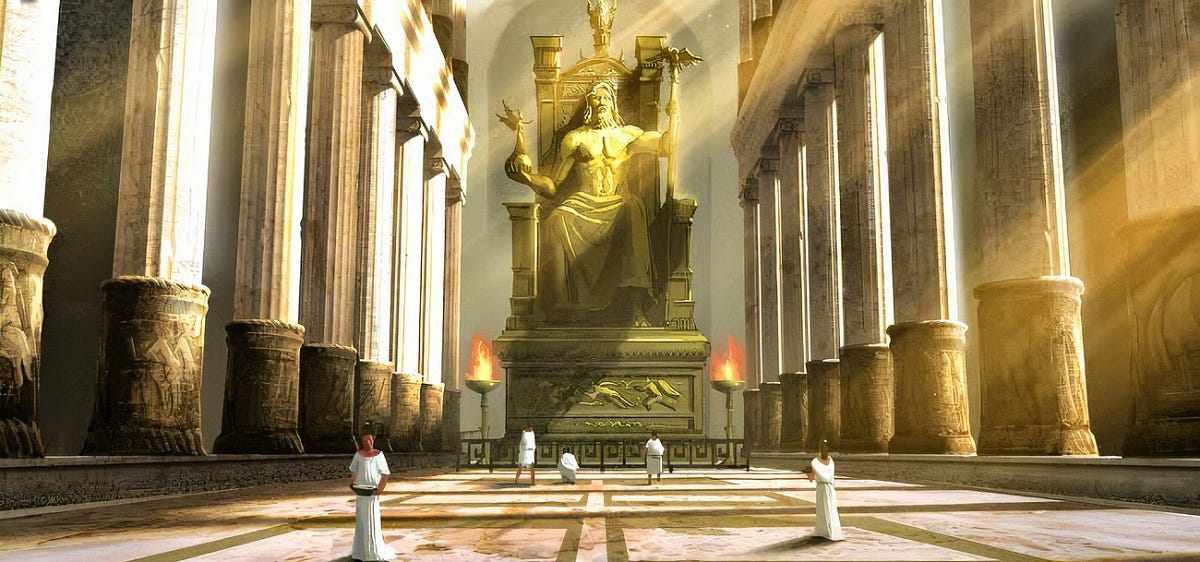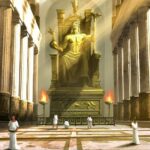The Statue of Zeus at Olympia remains one of history’s most captivating monuments, a work that people search for today not only to understand its physical form, but also to grasp its deeper cultural weight, mythological significance, and the artistry that made it one of the Seven Wonders of the Ancient World. This article answers that intent directly: explaining what the statue was, why it mattered, how it was built, what it symbolized, and what survives of its legacy today. Even though the statue no longer exists, its story continues to shape modern ideas about craftsmanship, religion, and the power of artistic imagination. The Statue of Zeus at Olympia is often remembered as a monument too extraordinary to survive, a masterpiece so ambitious that it seemed destined to live only in memory. Constructed in the 5th century BCE by the famed sculptor Phidias, the statue stood within the Temple of Zeus in Olympia, Greece, where it served as a combination of religious expression, political messaging, and artistic experimentation.
Today, when someone searches for information about the statue, they usually want more than a few lines they want a clear explanation that brings together history, art, architecture, and mythology in a way that feels complete and updated. This guide serves that purpose by combining narrative detail with approachable structure, offering a fresh and comprehensive look at one of humanity’s most storied creations.
Key Facts About the Statue of Zeus at Olympia
| Feature | Description |
|---|---|
| Location | Temple of Zeus, Olympia, Greece |
| Artist | Phidias, master sculptor of classical Greece |
| Construction Date | Around 435 BCE |
| Height | Approximately 12–13 meters (around 40–43 feet) |
| Materials | Ivory (for flesh), gold plates (for garments), wood framework, precious stones |
| Depiction | Zeus seated on an elaborate throne holding Nike (goddess of victory) |
| Cultural Purpose | Religious worship, political symbolism, celebration of Greek identity |
| Status | Destroyed; exact circumstances unclear; likely fire in late antiquity |
| Legacy | One of the Seven Wonders of the Ancient World; symbol of Greek artistic mastery |
1. The World That Created the Statue
To understand the statue fully, one must first imagine the world that produced it a Greece filled with competing city-states, cultural pride, and religious devotion.
1.1 A Sacred Landscape
The region of Olympia was not a city but a sanctuary a place where people came to honor Zeus. The Temple of Zeus, completed around 457 BCE, was meant to be the architectural crown of the site.
1.2 The Political Climate
Athens and Sparta dominated Greek politics at the time. The statue’s commission occurred during a period when Greek identity was evolving beyond city walls.
2. Phidias: The Mind Behind the Wonder
Phidias was no ordinary sculptor. His name appears repeatedly in discussions of ancient art, and even today, historians consider him a visionary who set the standard for classical beauty.
2.1 His Approach
Phidias believed that a statue should express divine presence, not merely portray physical form. This philosophy shaped Zeus’s posture, facial expression, and proportions.
2.2 Workshop Innovations
Phidias built an enormous workshop near the temple. Within its walls, he developed techniques for combining ivory and gold on a colossal scale something few artists had attempted.
3. Crafting the Statue: Techniques and Materials
Constructed with chryselephantine methods the combination of ivory for skin and gold for garments it was a shimmering blend of organic material and metal.
3.1 The Wooden Framework
The statue’s frame was made from cedar and other sturdy woods, designed to hold the hefty layers of ivory and gold without warping.
3.2 Ivory for Flesh
Phidias softened ivory sheets in warm water, shaping them to match the contours of Zeus’s arms, legs, torso, and face. The material gave the skin a smooth, lifelike glow.
3.3 Gold for Divine Radiance
Thin plates of gold draped over the statue’s robes and ornaments. Under torchlight and sunlight filtered through the temple roof, the statue shimmered in a way that ancient viewers described as otherworldly.
3.4 Precious Stones and Inlays
Jewels and colored glass were used to accent the throne, garments, and staff. The throne itself was a massive artistic project, adorned with scenes from myth and decorated with ebony and ivory.
4. What the Statue Looked Like
Although none of the statue survives today, ancient descriptions give us a detailed sense of its appearance.
4.1 Zeus Seated in Majesty
Zeus sat on an elaborate throne, his body relaxed but his presence unmistakably authoritative. His head alone was nearly human-sized to an average visitor standing at the base.
4.2 The Nike Figure
In Zeus’s right hand he held a small statue of Nike, the goddess of victory symbolizing power and endorsement.
4.3 The Staff
In his left hand rested a scepter topped with an eagle one of Zeus’s sacred symbols.
4.4 Garments of Gold
The shimmering gold cloak draped across his torso created an impression of divine luminosity. Visitors often remarked that the entire figure felt alive.
4.5 Throne Imagery
The throne featured carved reliefs showing Amazonian battles, mythological figures, and symbolic creatures.
5. The Temple of Zeus: A House for the Divine
The statue was not meant to stand alone; it existed in conversation with the temple that housed it.
5.1 Architectural Grandeur
With its towering Doric columns and sculpted pediments, the temple was one of Greece’s most impressive religious structures.
5.2 Light and Space
Openings in the roof allowed natural light to fall dramatically across the statue, emphasizing the gleam of the gold and ivory.
5.3 Rituals and Pilgrimages
Pilgrims who entered the temple often described the experience as transformative, with some claiming the sight of Zeus brought them peace or awe.
6. Symbolism and Cultural Meaning
The statue served multiple cultural purposes.
6.1 Religious Symbol
To the Greeks, the statue was not just art it was a physical manifestation of Zeus’s presence.
6.2 Political Messaging
The statue’s grandeur reminded visitors of Greek unity and the cultural power of the Greek world.
6.3 Artistic Achievement
It demonstrated the heights Greek craftsmanship could reach, setting standards for future generations.
7. The Decline and Mysterious Destruction
The statue survived for centuries, but its end remains unclear.
7.1 The Rise of Christianity
As Christianity spread through the Roman Empire, pagan temples were abandoned or repurposed.
7.2 Fire or Accident?
Some accounts say the statue was moved to Constantinople and later destroyed in a fire;
7.3 The Final Disappearance
By the 5th century CE, the statue was gone, leaving behind only references and replicas on coins and pottery.
8. Legacy in Modern Culture
Even though it has vanished physically, the statue’s legacy continues.
8.1 Archaeology
The remains of Phidias’s workshop were discovered in the 20th century, providing rare insight into ancient artistic labor.
8.2 Popular Media
Books, films, documentaries, and educational materials frequently reference the statue as emblematic of ancient creativity.
8.3 Tourism
Olympia remains a major archaeological destination.
8.4 Artistic Influence
Artists continue to study Phidias’s techniques and design principles.
9. Why the Statue Still Matters Today
The Statue of Zeus at Olympia symbolizes something more than myth or heritage it represents human capacity for imagination and craftsmanship.
9.1 A Lesson in Ambition
It shows that even in ancient times, artists dared to attempt the impossible.
9.2 A Study in Cultural Identity
The statue offers insight into how ancient societies projected power and belief.
9.3 A Reminder of Impermanence
Its destruction reminds us that even the grandest creations can fade, making the act of preservation ever more vital.
10. Conclusion
The Statue of Zeus at Olympia may have disappeared, but it continues to live in the stories, reconstructions, and imaginations of those who seek to understand it. From its technical brilliance to its symbolic reach, it remains one of the most influential creations of ancient Greece. To learn about this statue is to learn about artistry, religion, ambition, and the fragile nature of human achievement. If you stand today in the ruins of the Temple of Zeus, the air feels still, as if waiting for a presence that left long ago. But the memory remains a towering figure of gold and ivory, capturing the spirit of a civilization that believed beauty could bring the divine to earth.











